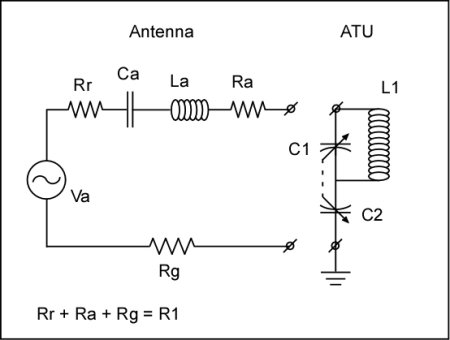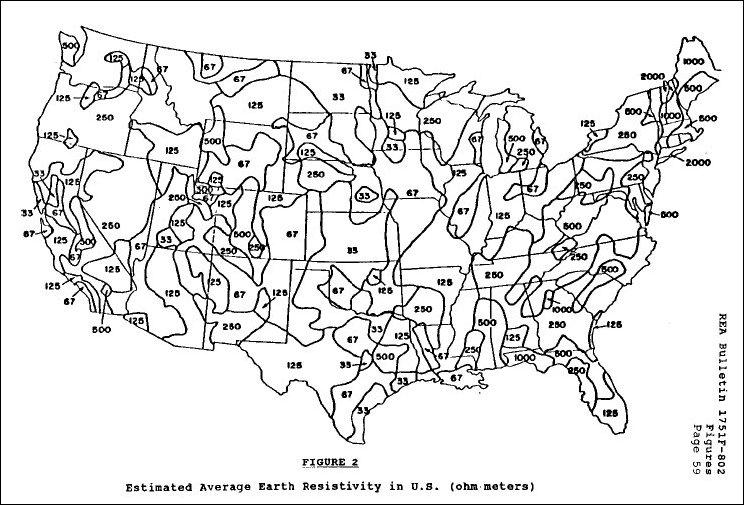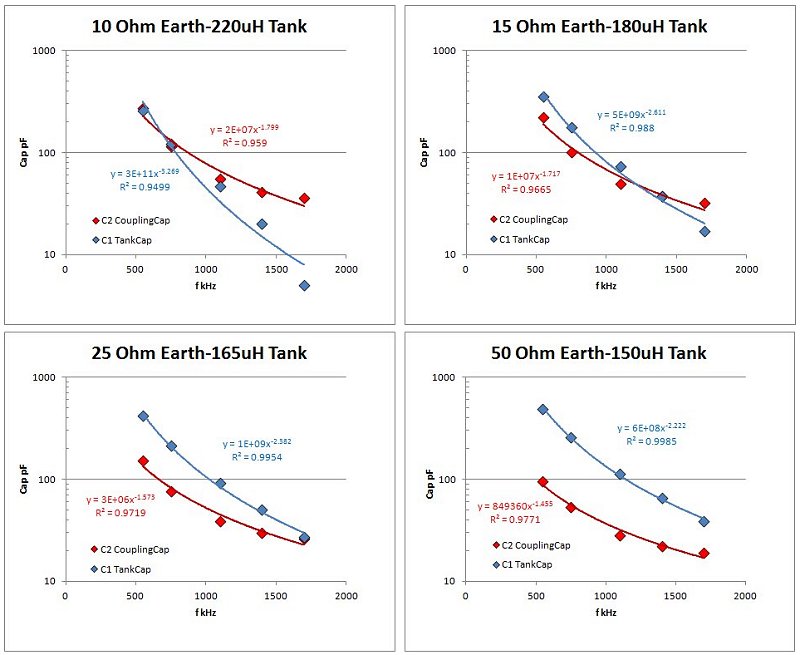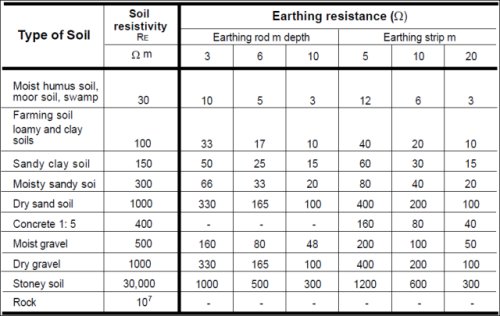

When designing my radios I always make extensive use of Mike Peebles and Dan Petersen's "Professor Coil" spreadsheet. This tool along with the many tutorials and explanations online have vastly eased the design work around homebrew coil winding. We can now model a coil with good accuracy prior to the actual job and thus better match the coil to the other components we plan to include. One quickly becomes aware that most coils for the broadcast band vary around a nominal 220 or so uH. More than this and most variable capacitors will have too much bottom-end capacitance to tune the top of the band. Less than this and you need caps with fairly high values when fully meshed, 500+pF or more.
All the above is pretty straight forward. On the other hand, when I have been reviewing double-tuned set designs, I often note that the coil used for the ATU (antenna tuning unit) will have an inductance quite a bit lower than the main tank coil. Professor Coil doesnít address this aspect of coil design and I have found little discussion online concerning ATU design. Mostly this seems to be dealt with in passing or as a digression when dealing with other subjects. The most useful web sites for addressing this aspect of crystal set design include Dick Kleijer's excellent work and Ramon Vargas's detailed analysis of the "Tuggle Front End", thatís about it. Neither site discusses the ramifications of varying different parameters such as the Earth Resistance, Coil Inductance, etc although Kleijier's site includes a great calculator page to allow one to ask these questions. In my explorations of ATU design (primarily Tuggle) I have made extensive use of Kleijier'e page and for this I am deeply in his debt. My hat's off to Dick, thanks so much.

The following discussion presents the results of many models cranked through the design calculator. I wished to understand what factors play main roles and which have minor parts.
For a conventional detector-circuit coil one can pretty much control all the main factors, really only the inductance and capacitance of the circuit. The main and only surprise comes in the form of "stray capacitance" resulting from the spacing of the coil wires. This can readily be 1) guessed at and 2) minimized by good coil winding technique. For the antenna circuit by contrast many of the needed parameters, earth resistance, antenna capacitance and inductance, and antenna resistance in the forms of actual wire resistance and radiation resistance are, for most of us, unknown and only guessed at. The following figure illustrates the antenna and ATU with a list of the main "components" that need to be understood and/or modeled.

The Antenna consists of an AC voltage source (the signal of interest) Va, in series with some radiation resistance Rr, antenna capacitance Ca, antenna inductance La, antenna resistance Rr, and finally a ground resistance for the return path to complete the circuit. In addition the ATU consists of a coupling capacitance C2, and a tank with inductance L1 and capacitance C1. The capacitance and inductance of the ATU is needed to tune out the reactance of the various components of the antenna for which we do not have data. What to do?
Without an antenna analyzer (expensive) one can only estimate the many component values based on published antenna models. Ken Kuhn's engineering page has a number of nice models and a good discussion of the antenna parameters we will be trying to understand and use. For my personal setup my antenna consists of about 75' of 14awg wire averaging about 10-12' high and with another 25' of lead-in. For such an antenna Kuhn models a 30m antenna 3m high which approximates my situation closely enough. Wire resistance is negligible as is the radiation resistance which he shows to vary between some 0.1 to 1.5 ohms. Such an antenna is capacitive by nature and will have about 220 - 375pF along with some small 20uH inductance, not too far off a standard "dummy" antenna. This pretty much leaves earth resistance Rg and the main unknown parameter.
For Rg one has the option of punting and taking the "Standard" value of 25 ohms. In my modeling I have found this parameter to be critical and highly sensitive. I do not recommend guessing here, it is recommended one go to the internet page of their state, county, or local government and search for reports on ground or soil resistivity (or conductivity). As this is an important agricultural and engineering parameter, it has been surveyed for most places and should be available with some effort. Effort well rewarded. Earth resistivity for the Texas Gulf Coast is a mercifully low 10 - 15 ohm meters, but for many regions this will not be the case.
Earth resistivity depends on a number of variables including the material, moisture, mineral salt, and temperature. A table of typical ranges in ohm meters for some different soils follows:
Loam 5 - 50 ohm meter Clay 4 - 100 Sand/Gravel 50 - 1,000 Limestone 5 - 10,000 Sandstone 20 - 2,000 Granite 1,000 - 2,000 Slates 600 - 5,000Moisture up to about 17% dramatically lowers resistivity, mineral salts are needed as pure water is an insulator, and as the temperature approaches freezing the resistivity also rises dramatically. All these factor into your estimation of Rg. The actual resistivity seen by the circuit depends on the earth resistivity and the type of grounding system you have installed. The more metal in the ground and deeper, the lower the resistance. Know thy earth! A map of USA soil resistivity follows:

Modeling:
All the above discussion is great but... What is important really? The following section presents the results of applying different parameters to get a feel for the sensitivity of it all. To begin with I need explain my base assumptions. All the models are based on Kleijer's calculation spreadsheet which requires inputs for the following parameters:
Frequency
Coil inductance
LC circuit Q unloaded
* Complex impedance of antenna or
Series Resistance (Rg+Ra+Rr)
Series Capacitance Ca
Series Inductance La
* If the series values are given, the complex impedance is calculated.
1) Frequency is chosen per your model, I have taken models at F = 550-1100-1700 kHz.
2) Coil inductance one has control over when winding. I have chosen base values that resonate with about 400pF tank capacitance, with some sensitivities.
3) Unloaded Q I do not have. For modeling I have taken Vargas's measures for a 4.5" coil wound with 660/46 Litz wire. I assume this will be about as good a coil as one can wind. I also made a sensitivity for lower Q. Q is a function of frequency and I have used the appropriate value of Q to match the modeled frequency.
4) Series Resistance is basically what the earth and ground system will deliver plus a small 1-2 ohm contribution from Ra and Rr. I have modeled four cases 10, 15, 25 and 50 ohms. The first two cases reflect my needs on the Gulf Coast with low resistivity soil. The 25 ohm case is a "typical" or "standard" ground. Finally, many will have much higher resistivity soils and you need to know just how difficult things can get!
5) Series capacitance I based for my specific antenna on the model of Ken Kuhn (Mathematical Model of Wire Antenna). The capacitance of a 30m antenna 3m high he calculated to range from 220pF and low frequencies to 375pF and high frequencies. I input the correct capacitance to match the frequency modeled.
6) Series inductance I just input 20 uH every time.
The data and plots for four different scenarios follow:

The above plots show the calculated capacitance versus frequency for four different models of Earth Resistivity / Tank Inductance. In each case I maintain the same log capacitance vs frequency scale for easy comparison. The cases modeled represent increasing earth resistance presented to the ATU from a very low 10 ohms to a fairly high 50 ohms. Actual earths can go up to two orders of magnitude higher. I chose L1 inductances such that the maximum needed capacitance would approach 500pFs, easily found on many variable caps. With respect to the coupling cap (C2, red curve), as the earth resistivity increases, the needed capacitance declines. The tank cap value needs to resonate with the inductor and increases with smaller-value inductance. In searching for a 500pF cap max value, the choice of inductance needs to decrease with increasing earth resistance. Parameters other than Rg, L1 and C1-C2 have minor impact on the models.
Conclusions:
From the plots one can readily see that above 15 ohm earth the two variable capacitors on the ATU do not track well. As the earth resistivity increases, the worse the tracking. Most locations are not blessed with a low resistivity earth and this needs to be factored into the ATU design. There is little to be done, changing the design coil inductance will change the needed capacitance on BOTH C1 and C2, (larger L1 leads to smaller C1 and C2 for resonance and vice versa). A possible solution well worth trying is to use a dual-gang capacitor where one section has a different value than the other, the above plots give an easy way to decide the max values needed. Use the smaller gang on the coupling circuit and the larger on the tank. Experience tells us that ganging the capacitors on a "Tuggle" front end works well, but from the models I have to imagine one might squeeze a bit more performance by giving up the convenience of one-dial tuning on the ATU, especially where your earth has a fairly high resistance.
The best design methodology requires that you know first and critically your earth resistance. If this is just a guessed-at parameter then I strongly urge you to put down the Litz, set aside the silver-plated-ceramic-insulated caps, box the holy-grail diodes and go do some research on your local ground. All the time, expense, and effort on the greatest "state-of-the-art" crystal receiver will be wasted if the ground is not attended to. If the resistivity of your earth is high in ohm-meters, get more metal in the ground or consider a counter-poise. The following table from LEM Instruments shows the relation between earth resistivity in ohm meters and actual earth resistance in ohms as a function of the earthing method used.

Given just how little discussion there is on the web concerning antenna tuning and the impact of ground resistivity I hope this page can serve as a starting point for further research. Certainly there is more to be said, Crystal Radio, its a bottomless pit!
Kevin Smith
09/2011

Models and Data:
10 ohm / 220 uH Lowest resistivity Earth Case sensitivities Ra Ca La L5 Qu f C4 cpl C6 tank Za Impedance LC Rp Ohm pF uH uH kHz pF pF Ohm kOhm 10 220 20 220 475 550 442 228 10 -j 1246 361 10 300 20 220 400 1100 68 36 10 -j 344 608 10 375 20 220 200 1700 44 -3 10 -j 36 470 10 220 20 220 700 550 273 255 10 -j 1246 532 10 260 20 220 640 750 114 122 10 -j 721 663 10 300 20 220 585 1100 55 47 10 -j 344 890 10 340 20 220 440 1400 41 20 10 -j 158 851 10 375 20 220 300 1700 36 5 10 -j 36 705 10 220 20 200 700 550 304 287 10 -j 1246 484 10 300 20 200 585 1100 58 54 10 -j 344 807 10 375 20 200 300 1700 38 7 10 -j 36 641 15 ohm / 180 uH Low resistivity Earth Case sensitivities Ra Ca La L5 Qu f C4 cpl C6 tank Za Impedance LC Rp Ohm pF uH uH kHz pF pF Ohm kOhm 15 220 20 180 475 550 337 328 15 -j 1246 295 15 300 20 180 400 1100 61 63 15 -j 344 498 15 375 20 180 200 1700 40 10 15 -j 36 385 15 220 20 180 700 550 220 352 15 -j 1246 435 15 260 20 180 640 750 100 176 15 -j 721 543 15 300 20 180 585 1100 49 73 15 -j 344 728 15 340 20 180 440 1400 37 37 15 -j 158 697 15 375 20 180 300 1700 32 17 15 -j 36 577 15 220 20 130 700 550 313 511 15 -j 1246 314 15 300 20 130 585 1100 59 110 15 -j 344 526 15 375 20 130 300 1700 38 30 15 -j 36 417 15 220 20 205 700 550 195 302 15 -j 1246 496 15 300 20 205 585 1100 45 61 15 -j 344 829 15 375 20 205 300 1700 30 13 15 -j 36 657 25 ohm / 165 uH "Standard" resistivity Earth Case sensitivities Ra Ca La L5 Qu f C4 cpl C6 tank Za Impedance LC Rp Ohm pF uH uH kHz pF pF Ohm kOhm 25 220 20 165 475 550 213 396 25 -j 1246 271 25 300 20 165 400 1100 48 84 25 -j 344 456 25 375 20 165 200 1700 32 22 25 -j 36 352 25 220 20 150 700 550 164 462 25 -j 1246 363 25 300 20 150 585 1100 41 102 25 -j 344 606 25 375 20 150 300 1700 27 31 25 -j 36 481 25 220 20 165 700 550 151 416 25 -j 1246 399 25 260 20 165 640 750 76 213 25 -j 721 498 25 300 20 165 585 1100 39 91 25 -j 344 667 25 340 20 165 440 1400 30 50 25 -j 158 639 25 375 20 165 300 1700 26 27 25 -j 36 529 25 220 20 200 700 550 130 335 25 -j 1246 484 25 300 20 200 585 1100 35 72 25 -j 344 807 25 375 20 200 300 1700 24 20 25 -j 36 641 50 ohm / 150 uH High resistivity Earth Case sensitivities Ra Ca La L5 Qu f C4 cpl C6 tank Za Impedance LC Rp Ohm pF uH uH kHz pF pF Ohm kOhm 50 220 20 150 475 550 128 476 50 -j 1246 246 50 300 20 150 400 1100 34 108 50 -j 344 415 50 375 20 150 200 1700 24 35 50 -j 36 320 50 220 20 150 700 550 96 490 50 -j 1246 363 50 260 20 150 640 750 53 256 50 -j 721 452 50 300 20 150 585 1100 28 113 50 -j 344 606 50 340 20 150 440 1400 22 65 50 -j 158 581 50 375 20 150 300 1700 19 39 50 -j 36 481 50 220 20 125 700 550 110 595 50 -j 1246 302 50 300 20 125 585 1100 31 139 50 -j 344 505 50 375 20 125 300 1700 21 49 50 -j 36 401
